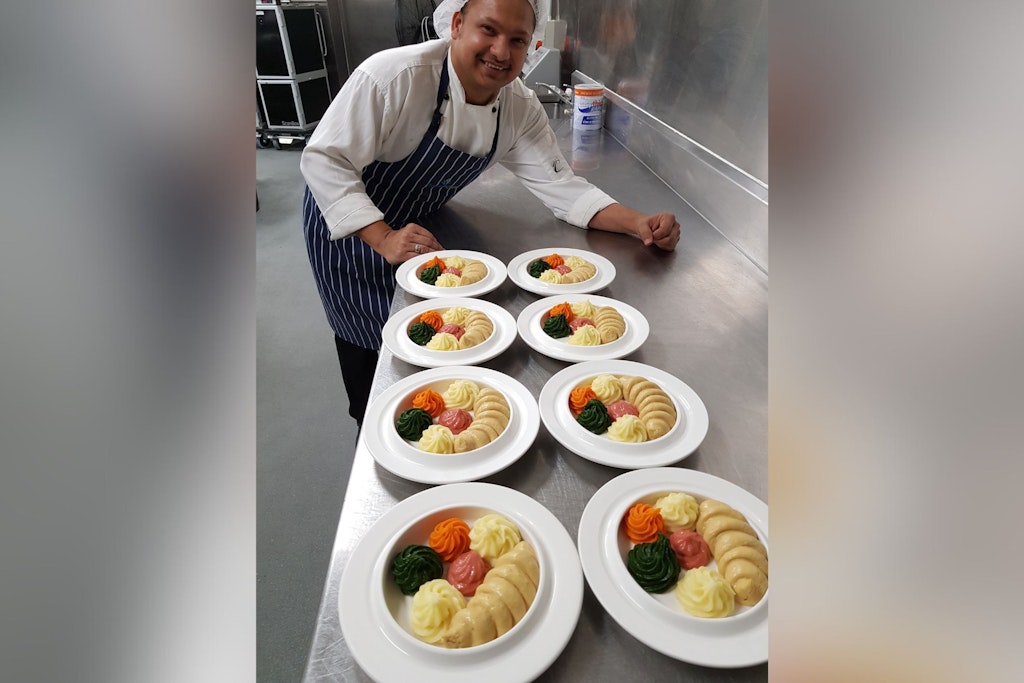An insider look at the importance of hospitality, food and the dining experience
Last updated on 24 April 2024

Food and hospitality play an important yet sometimes underappreciated role in aged care. Yet the satisfaction of a good meal, pleasant dining experience and constructive relationship between residents, chefs and kitchen staff is intrinsic to a quality aged care experience.
Its impact is further supported by the Government’s focus on food and nutrition (Standard 6) in the strengthened Aged Care Quality Standards. The Food and Nutrition Standard urges providers to engage with older people about what and how they like to eat and drink with choice essential.
Creating a positive dining room culture is challenging, though, and experience is often essential as it helps aged care staff adopt a more flexible and person-centred approach. Stuart Walton, BaptistCare’s Hotel Services Manager, told hello leaders that the first step to strengthening the dining experience is engaging with residents.
“We want these dining rooms to feel like a home and getting the residents involved is going to help you understand exactly what they’re looking for. Engagement with residents allows your staff to get to know who they are,” explained Mr Walton.
“The dining room also provides an opportunity to socialise. Table settings should look inviting so the residents look forward to spending time there. It is not just about food, it’s about loneliness.”
“With staff engagement you want interactions with residents to feel homely as well. You don’t want care staff or employees delivering food with rubber gloves making it feel like there’s a clinical setting.”
The dining experience is closely linked to what occurs behind the scenes, in the kitchen, as well. There, one of the top concerns can be food wastage, particularly when it comes to residents not eating all of their meals.
This is a complex topic for Mr Walton as he acknowledges that there are numerous factors influencing why food wastage occurs. On one hand, it can be kitchen overproduction, while on the other it’s teams not properly monitoring and reacting to the amount of food residents are eating.
“You need to be monitoring waste. In most aged care homes there are various choices for lunch and dinner so you must know what you’re ordering and providing. If there’s leftover food you need to be looking at it and readjusting your ordering levels to match what the consumers want out of those choices,” said Mr Walton.

“On the other side of the coin, there’s nutritional compliance. We have something called plate counts which is based on certain weights for proteins and vegetables. We never want to compromise plate counts unless the clinical information system tells us to reduce portions.
“So if we were to look at wastage, if you provided the correct plate count and a resident wasn’t eating all their food – especially if it starts to become a pattern – then we need to engage with that resident.”
He recommended discreetly talking to residents about why they aren’t eating all their meals as it may be due to mouth ulcers, poorly fitting dentures or loss of appetite. A chef can typically initiate the conversation before escalating it to a nurse or clinician if necessary.
Eye-catching food presentation
If table settings are one way to entice residents into the dining room, the food presentation has to be on another level. Meals should match up to how the menu describes them, just like any quality restaurant, and they should never lose quality or appeal because of dietary requirements.
Texture-modified foods are an essential consideration in aged care. Approximately one-third of residents consume texture-modified foods so their diets will be influenced by the International Dysphagia Diet Standardisation Initiative (IDDSI) Framework.
Mr Walton said the transition from a normal diet to a puree diet can be difficult enough for residents, so presentation and the integrity of food are paramount to a successful dining experience.
“A few years ago we did a course with Maggie Beer and Amanda Orchard [Chef, Maggie Beer Foundation] and we loved the concept [of rethinking texture-modified foods] and the piping she was doing. We adopted that concept,” he explained.
“With some older processes of using ice cream scoops to serve food or buy already moulded food, if you heat that food too much, it collapses and doesn’t look very appealing. When that comes out the resident has already decided whether it looks good or not and that may deter them from eating all of it.”
“There’s a wow factor there. Same as when you go to a restaurant. You read the menu, you’re waiting in anticipation to see if what you read on the menu is going to come out on the plate looking just as good as you imagined.”
“We use a 6D reduction and cook at lower temperatures to hold an inner core temperature and gain a better product at the end. When the food comes to the residents it looks appealing, it’s colourful, they can identify the protein and they’re more likely to eat it.”

A team approach to success
If food presentation is one solution to prompting residents to eat more of their meals, what else can kitchen and hospitality staff do to reduce food wastage? There are a few approaches to help both in the kitchen and throughout the residential care setting.
- Spot checks to see if there’s less wastage in rubbish bins are always helpful as you can physically check how many leftovers are piling up
- If overproduction is a concern, electronic systems that provide full recipe requirements will help align orders with production requirements
- Meanwhile, checking the temperature of food is important when complying with food safety, but monitoring the temperature during transportation is also essential
- Food that is transported to dining rooms or private bedrooms can cool down, compromising flavours and changing textures and putting off residents
- The impact of technology is not limited to planning and production as resident surveys and data analysis can positively influence future menus
Spot checks and quality checks are both essential, said Mr Walton, and they’re everyday steps that can make all the difference in a seamless dining experience from production to clean-up.
“We’re checking that the food is hot enough and if it’s not then we find another solution. Say you were taking ten meals out to residents eating in their rooms, you may change the frequency to five people at a time to keep them warmer,” explained Mr Walton.
“If it’s sitting in the dining room it’s cooling down as well and you may have a resident who eats slowly and you never want to rush them. But if the food’s going cold you could take out half a portion to them and then bring out the other half once their finished and it’s still warm. You’re going to encourage people to enjoy their food and see less plate wastage.”
Technology’s influence in the kitchen is also increasing and hospitality will be one of the next sectors to experience a digital transformation. Many processes have already gone paperless, or are currently transitioning from paper to digital, including food safety programs and product management.
This digital growth will further enable staff to support resident choice. For example, employees can better monitor what foods certain residents cannot eat, easily adapting recipes to cater to allergens and intolerances. Clinical systems are also better ingrained in food and nutrition processes with real-time data set to be a game changer.
“Technology plays a big part and it’s definitely going to help reduce food wastage. Once you start using technology properly, such as capturing information for recipes, you can go into a system and change the quantities and modify things much easier than on paper,” added Mr Walton.
Ultimately, most if not all of these processes involve staff and resident interaction. Staff are instrumental in identifying issues and finding solutions and increasing their knowledge will increase positive food and nutrition outcomes.
Active involvement in everyday processes will enable staff to learn and grow, as does fostering a positive food experience culture. Educate and highlight the implications of not supporting residents with their dining experience
“I think everybody should know the processes, and to me, the more your staff know about processes, the better the processes are going to work. Culture plays a part in that,” said Mr Walton.
“When you have a food safety program and educate people properly, tell them the implications of not following it they will get on board and you don’t have to police the program because people believe in what you’re doing. Involving the staff means you’re going to get better results.”